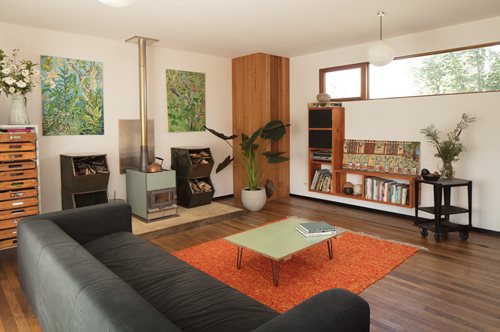

Recyclable House: The ultimate in sustainable design and construction
This house is a cutting-edge example of design and construction for recyclability, with designer Quentin Irvine using experimental closed-loop design and construction methodologies.
This house is a cutting-edge example of design and construction for recyclability, with designer Quentin Irvine using experimental closed-loop design and construction methodologies.

From the designer:
While learning the building profession I identified and became frustrated with the fact that most Australian homes are essentially built with/for rubbish whether they were promoted as eco-friendly homes or not. Even though materials were often coming to site as quality recyclable materials, they would be destined for landfill the minute that they were installed due to the building practices and installation methods used. I found solutions to many of these problems by researching older building methods as well as thinking creatively about the problem.
Building with recycled materials
There are a number of recycled features in the house - mostly timber as floorboards, wall linings and joinery. Although the use of recycled wood is good as it lowers the embodied energy in the build, and is also good from the perspective of not consuming new forestry resources - the use of these materials is also where the closed loop design philosophy falls down. This is because we don’t know where these materials have been and don’t know the content of the finishes used on them.
Consequently we cannot determine how safe these would be for natural recycling through burning or composting without further analysis. Sadly, I can almost guarantee that the finishes on much of the old floorboards would be in some way toxic, as for example lead was often used in clear coat timber finishes. We did our best to mitigate this problem by re-machining the recycled timber that was used in the house, and finishing it with natural oil finishes.

Walls so good you could eat them!
Well you wouldn’t just munch into a wall, but as they are fully compostable they could ultimately enter the food chain. By using the older style plaster board that was readily available in 2015, installing it without glue (screws only) and painting it with natural paint (I mean natural paint, not low VOC acrylic/ plastic paint), you have a wall lining which is essentially paper, gypsum and a few other inert ingredients. Assuming these materials are not contaminated down the track, you have a wall lining that can be composted and used as a soil improver. You then get to eat the walls when your crop sets!
How does one build a recyclable bathroom?

Most bathrooms start with tile substrates (chipboard or cement sheets) being glued and nailed to walls and floors, followed by waterproofing membranes and tiles being applied to these. At the end you have four or more different materials stuck together. Congratulations, you just created landfill. It might serve for a long while as a waterproof bathroom, but the tiles, cement sheet, chipboard, glue and chemical membrane have all started their slow but certain one-way trip to landfill.
We built our bathrooms using similar techniques to roof building. I first got the idea for this from an architect friend named Ann Cameron, and adapted it to make it as recyclable as possible.
We started with recyclable and partly recycled cement sheet that we screwed, not glued, to the floor structure. We then built waterproof, stainless steel floor trays/shower trays that had floor/shower wastes installed. These acted as the waterproofing layer (once again not glued down).
From here we used floating decking boards in one bathroom, and pebbles/pavers in another. For a more conventional finish, you could use tiles on a sand/cement mortar bed for floors and still keep it fully recyclable.
Recyclable building envelope sealing
Building air tightness is all the rage at the moment, but to use a common Australian aluminium/plastic-foil building wrap and to fill every nook and cranny with an acrylic/chemical filler and expanding polyurethane foam is not recyclable.
Instead of these non-recyclable wall wraps we used recyclable polyester breather wrap for wrapping the house walls. This is just as good for air tightness but is vapour permeable therefore keeping the wall cavities and the home dryer, mould free and healthier. It is like “Gortex” fabric for your home.
Instead of smearing filler and expander foams all over good recyclable timber, we used correctly installed flashings and correctly lapped and stapled wall wrap to keep things as air tight as possible. We then used rock wool insulation to fill any remaining tricky gaps.
External Finishes / Materials
The weatherboard-clad home seen so often in the Australian home design landscape, is a curse on any sensible homeowner. Traditional painted timber weatherboards have extremely low longevity and are non-recyclable due to the painting. The modern cement sheet and Masonite counterparts are a longer lasting solution but are still not fully recyclable due to the paint.
I chose Z600 galvanised corrugated steel as the predominant external cladding primarily for its superior durability and recyclability, but also as an aesthetic homage to the iconic Australian woolshed. I also chose galvanised steel as opposed to zinc/aluminium coated steel as I believe it’s a safer surface to collect drinking water from. To break up the austerity of the external façade we experimented with charring our own Australian, locally milled timber for the north-facing façade.

Yakisugi (charred timber), a Japanese cladding technique has been used in Japan for hundreds of years, due to the processes’ multiple benefits – fire retarding, rot resistant, carbon sequestering, fully recyclable, and extremely low maintenance. The Yakisugi burning process also utilised the offcuts from installation of the charred cladding as a fuel source for manufacturing the product. This provides an example of the potential for closed loop manufacturing systems using this material.



